Software testing stands as a cornerstone of successful software development, delivering crucial benefits that extend far beyond simple bug detection. In today's rapidly evolving digital landscape, understanding the comprehensive benefits of software testing has become essential for organizations aiming to deliver high-quality products while maintaining competitive advantage.
From traditional manual testing to advanced automation frameworks, software testing continues to evolve, offering increasingly sophisticated ways to ensure software quality and reliability.
1. Understanding the Fundamental Benefits of Software Testing
The impact of software testing on product quality and business success cannot be overstated. Organizations implementing robust testing practices consistently report significant improvements in software quality, customer satisfaction, and operational efficiency. According to recent industry studies, detecting and fixing defects during the testing phase costs up to 15 times less than addressing issues after deployment.
Real-world Impact on Software Quality Software testing's most immediate benefit is its ability to ensure product quality and reliability. When companies like Netflix implemented comprehensive testing strategies, they reported a 70% reduction in production incidents. This improvement stems from testing's ability to:
- Identify functional issues before they reach end-users
- Ensure consistent performance across different platforms
- Validate user experience and interface functionality
- Maintain compliance with industry standards and regulations
Cost Savings Through Early Defect Detection
Early detection of software defects through systematic testing provides substantial cost benefits. Research by the National Institute of Standards and Technology indicates that fixing bugs after release can cost up to 30 times more than addressing them during development. This economic advantage becomes particularly evident when considering:
- Reduced maintenance costs
- Lower customer support requirements
- Minimized risk of reputation damage
- Decreased need for emergency fixes
Risk Mitigation Strategies
Effective testing serves as a crucial risk management tool, helping organizations:
- Protect against security vulnerabilities
- Ensure regulatory compliance
- Maintain business continuity
- Preserve brand reputation
2. Types of Software Testing and Their Specific Advantages
In today’s fast-paced software development world, ensuring high-quality releases is crucial. With various testing methods available, selecting the right approach—whether manual for human insight, automated for efficiency, or BDD for collaboration—can greatly impact your QA strategy. Modern frameworks further enhance these methods, streamlining processes and improving workflow.
2.1 - Manual Testing Benefits
While automation is gaining widespread use, manual testing remains a critical component of software quality assurance. Its unique advantages include:
- Exploratory Testing Scenarios: Manual testers can creatively explore the application to identify unexpected behaviors or edge cases that automated tests might overlook. This flexibility is crucial for discovering new defects in areas where pre-defined automated scripts may not reach.
- User Experience Evaluation: Evaluating how an end-user will interact with the software requires a human touch. Manual testing helps assess the look, feel, and overall user experience, ensuring the application is intuitive and meets user expectations.
- Initial Test Case Development: Before automating, manual testing is often used to validate the initial functionality of new features. This allows testers to understand the behavior and design more effective automated scripts.
- Complex Test Scenarios Requiring Human Insight: Some scenarios, like those involving visual regression testing, pull request testing, ambiguous requirements, or complex workflows, require human judgment. Manual testers can identify nuances and issues that may be difficult for automation to catch.
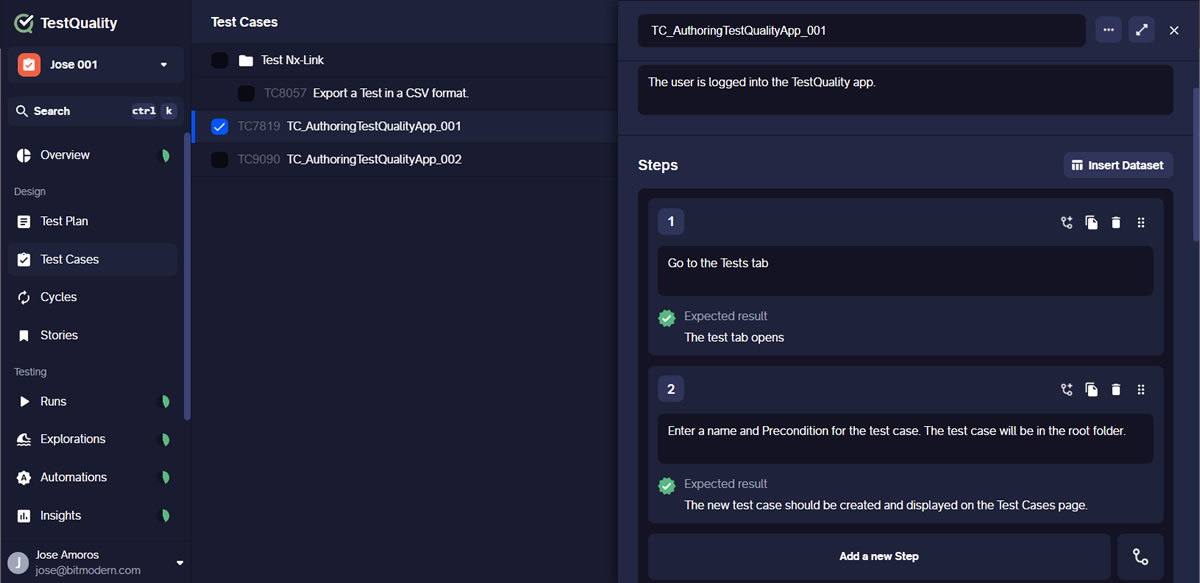
TestQuality facilitates to create, edit, organise your tests in to folders, and arrange their run order.
2.2 - Automation Testing Benefits
Automated testing has transformed how software testing is approached, providing numerous benefits:
- Faster Test Execution: Automation tools can run tests significantly faster than manual execution, especially when dealing with large test suites or repetitive tasks. This accelerates the feedback loop and supports agile and continuous integration/continuous deployment (CI/CD) practices.
- Consistent Test Results: Automated tests are less prone to variation caused by human factors, ensuring consistency and reliability in testing outcomes.
- Increased Test Coverage: Automation allows for extensive test coverage, including checking the application across different browsers, platforms, and scenarios, which would be time-consuming manually.
- Reduced Human Error: Automation minimizes the risk of human errors during testing, ensuring accurate and repeatable results every time.
- Cost-Effective Regression Testing: Automating regression tests saves time and effort, especially when frequently testing an application for stability after changes, making it more cost-efficient in the long run.
ROI of Test Automation Organizations implementing test automation typically see:
- 40-50% reduction in testing time
- 70% decrease in manual testing costs
- 90% improvement in test coverage
- Significant reduction in human error
Major companies have achieved remarkable results through test automation:
- Amazon reduced deployment time by 75%
- Google achieved 85% test automation coverage
- Microsoft reduced testing costs by 50%
2.3 - BDD (Behavior Driven Development) Approach
The BDD approach has revolutionized testing methodology by promoting collaboration and ensuring the software meets business requirements. Its specific advantages are:
- Improves Communication Between Team Members: BDD uses natural language to write test scenarios, making it easier for technical and non-technical team members to understand and contribute to the testing process. This shared understanding fosters collaboration and reduces miscommunication.
- Ensures Alignment With Business Objectives: By involving stakeholders from the start and focusing on the behavior of the software, BDD ensures that development aligns closely with business goals and user needs.
- Creates Living Documentation: BDD scenarios double as documentation, providing a clear, up-to-date reference for how the system should behave. This "living documentation" is easy to maintain and evolves with the software.
- Facilitates Test Automation: BDD seamlessly integrates with test automation frameworks, making it easy to automate scenarios using tools like Cucumber, SpecFlow, or JBehave. This improves efficiency and ensures behavior expectations are continually validated.
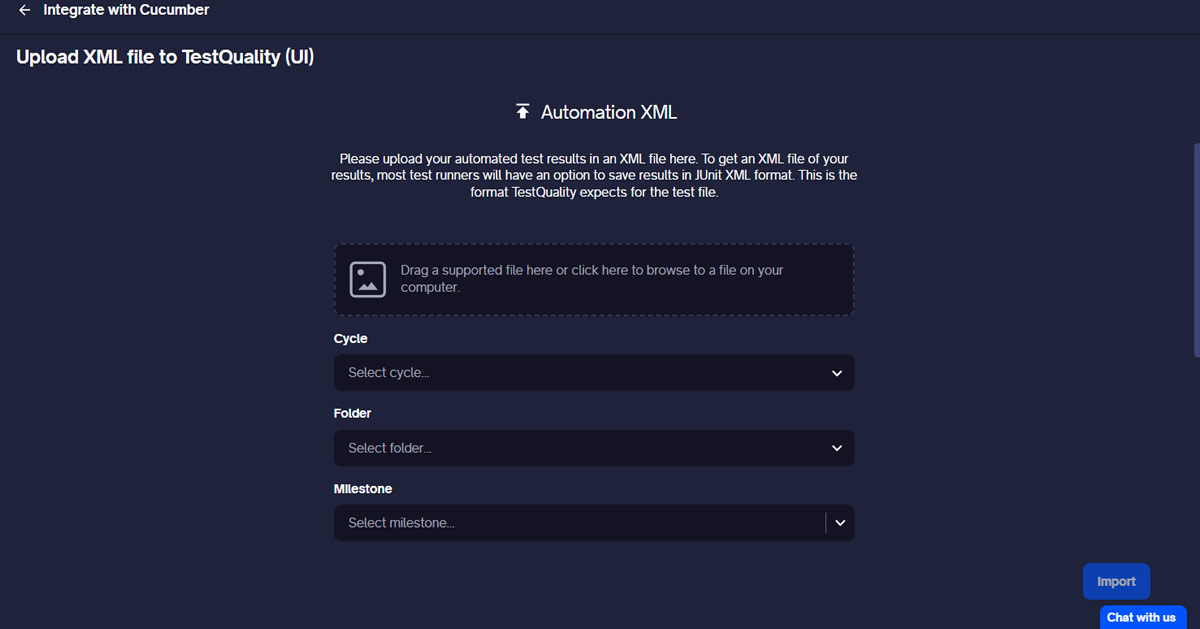
TestQuality's integration with Cucumber can effectively manage, organize, and report your Cucumber test results.
As we discussed in a previous post about Gherkin and Cucumber best practices, BDD implementation requires:
- Clear feature files using Gherkin syntax
- Proper step definitions
- Regular maintenance and updates
- Integration with automation frameworks
2.4 - Integration with Modern Testing Frameworks
Modern testing frameworks have become an essential part of software testing, significantly enhancing efficiency and flexibility. Their key benefits include:
- Supporting Multiple Programming Languages: Many modern frameworks are language-agnostic, enabling teams to write and run tests in a variety of languages, such as Java, Python, JavaScript, and more. This flexibility allows teams to choose the best language for their project requirements and skillsets.
- Providing Robust Reporting Capabilities: Comprehensive reporting features offered by these frameworks help in visualizing test outcomes, identifying issues quickly, and understanding the overall quality of the application. This empowers stakeholders to make data-driven decisions.
- Enabling Continuous Integration/Continuous Deployment (CI/CD): Modern frameworks integrate seamlessly with CI/CD pipelines, automating tests and providing instant feedback on the impact of code changes. This integration ensures rapid, reliable releases while maintaining high-quality standards.
- Facilitating Cross-Platform Testing: They support testing across different platforms, devices, and browsers, ensuring the application performs consistently for all users. Cross-platform testing is crucial for delivering a robust and user-friendly experience in today’s diverse technology landscape.
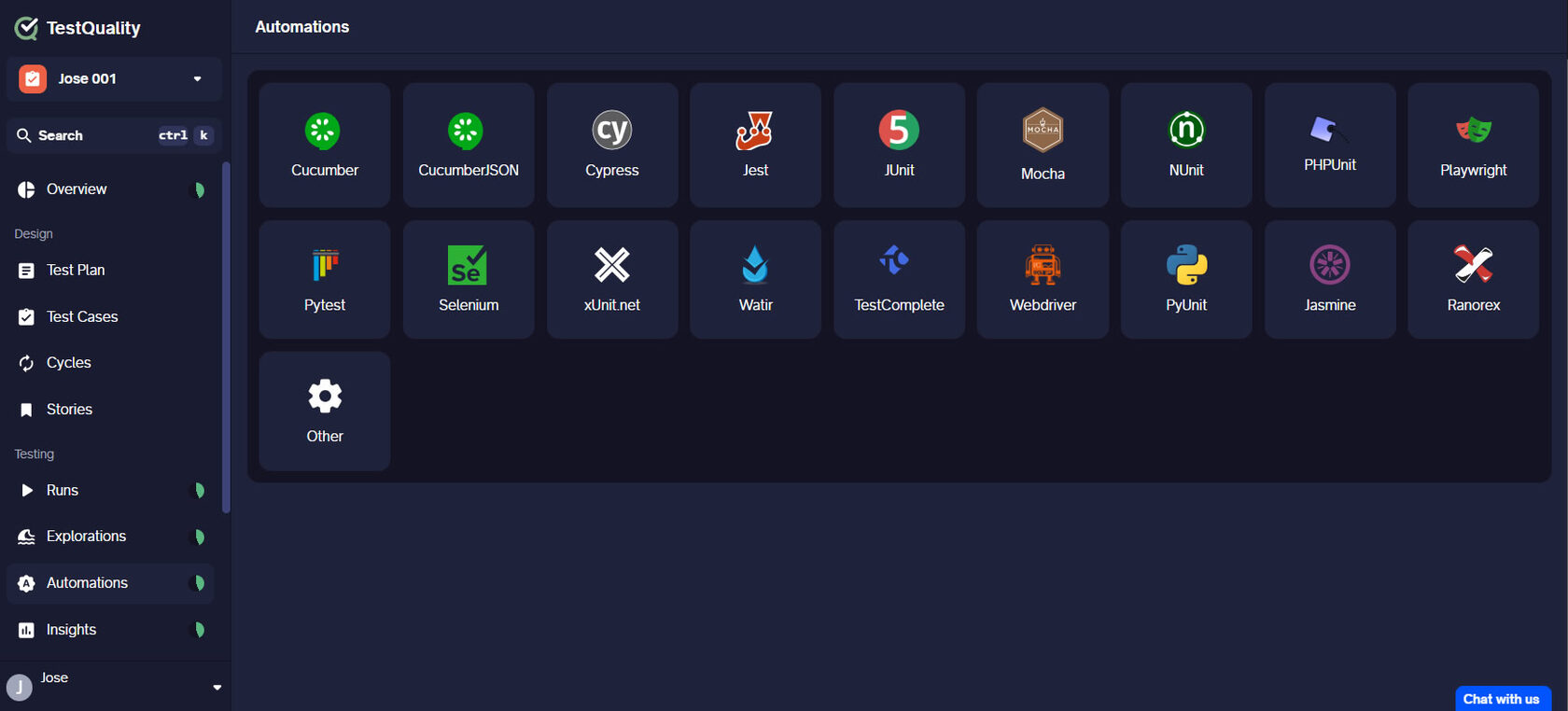
Choosing the right mix of testing methods is essential for reliable software. Manual testing provides human insight, automation delivers speed, and BDD fosters collaboration. By integrating these with modern frameworks, your team can ensure a seamless QA process that meets quality standards and enhances user satisfaction.
2.5 - Ad-Hoc and Exploratory Testing: Embrace the Power of Flexibility
Uncovering hidden defects and ensuring comprehensive test coverage requires more than just scripted tests. That’s where TestQuality’s built-in Exploratory Testing feature, known as "Explorations," comes into play. This innovative capability empowers QA teams, testers, and software developers to step away from rigid test scripts and explore applications freely, using their intuition and experience to catch unexpected issues.
- Identify Unexpected Issues: Exploratory testing allows your team to think beyond documented requirements. This approach can reveal usability problems, performance bottlenecks, and security vulnerabilities that traditional testing methods might overlook. By investigating these hidden defects, you ensure a more robust and reliable application.
- Boost Team Flexibility: With TestQuality, your testers can adapt their strategies on the fly, making real-time decisions as they learn more about the application's behavior. This flexibility enhances the testing process, helping you respond more effectively to complex or unpredictable scenarios.
- Streamline Workflows: Our platform seamlessly integrates Exploratory Testing with core functionalities, enabling efficient progress tracking, detailed documentation of findings, and generation of insightful reports. TestQuality’s unified approach makes it easier than ever to combine structured and exploratory testing for a well-rounded QA strategy.
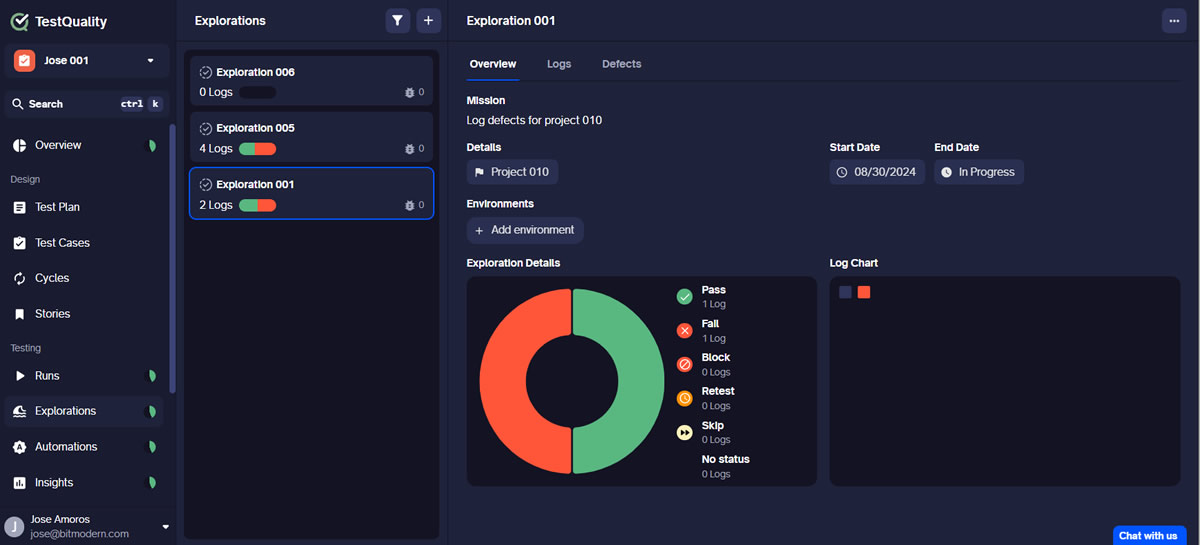
Ready to see how Exploratory Testing can elevate your quality assurance efforts? Start a Free Trial of TestQuality and experience a new level of software testing efficiency and effectiveness. Don’t miss the chance to discover and fix issues before they impact your users— start your free trial today!
3. Test Planning: The Foundation of Successful Testing
Effective software testing begins with a solid foundation: a well-thought-out test plan. Test planning is crucial because it outlines the strategy and scope of testing activities, ensuring resources are used efficiently and objectives are met.
Remember that without structured planning, testing can become chaotic, leading to missed defects, wasted time, and a poor understanding of testing goals. By focusing on establishing clear objectives, managing resources, and setting measurable success criteria, teams can ensure a smoother path to delivering high-quality software
3.1 - Benefits of Structured Test Planning
A structured test plan acts as a blueprint, guiding teams through the testing process with clarity and purpose. Here are the key benefits:
- Establishing Clear Testing Objectives: Defining what needs to be tested and the expected outcomes ensures alignment among stakeholders and sets a clear direction for the testing team. Objectives help prioritize critical areas of the software, focusing efforts where they are needed most.
- Defining Resource Requirements: Proper test planning identifies the necessary resources, including team members, tools, environments, and budget. By understanding these needs early on, teams can avoid delays and ensure that all elements are in place for a successful testing effort.
- Setting Realistic Timelines: A well-structured plan outlines a timeline that considers development schedules, dependencies, and test execution phases. Realistic timelines help manage expectations and prevent bottlenecks, allowing for a more organized and efficient testing process.
- Creating Measurable Success Criteria: Defining what success looks like enables teams to evaluate the effectiveness of their testing efforts. Success criteria provide a way to measure progress and determine whether the testing objectives have been achieved.
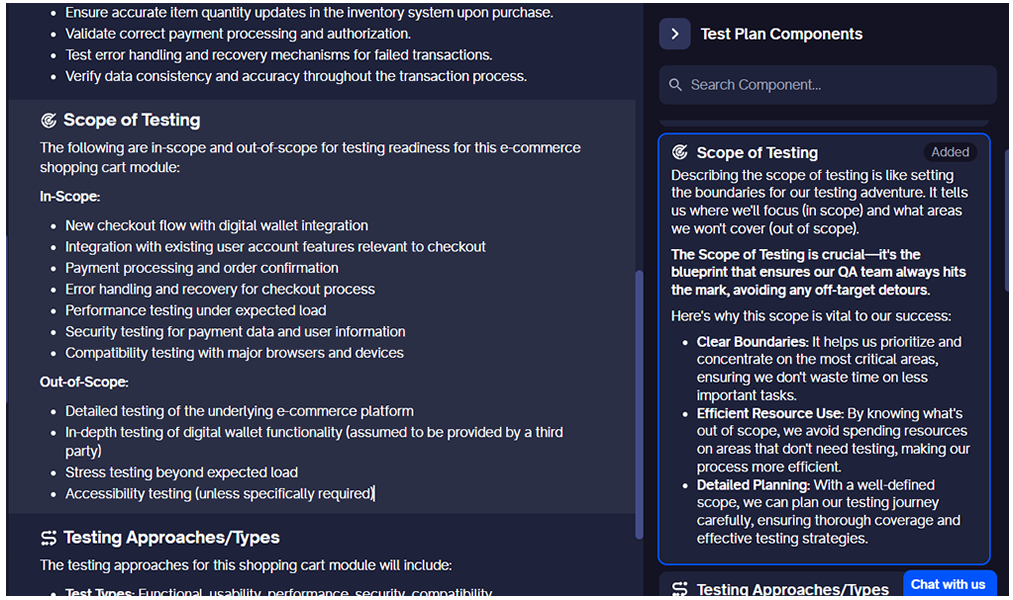
TestQuality Test Plan Builder enhances your test planning by allowing you to add Test Plan Components dynamically.

3.2 - Creating Effective Test Plans Using Gherkin
Gherkin language has become an essential tool for developing clear and effective test plans, especially in Behavior Driven Development (BDD) practices. Here’s how Gherkin contributes to the test planning process:
- Clear, Human-Readable Syntax: Gherkin uses a simple and natural language syntax that makes test scenarios easy to understand for both technical and non-technical stakeholders. This clarity helps in ensuring everyone is on the same page regarding what is being tested and expected outcomes.
- Structured Scenario Documentation: Gherkin’s format encourages structured and organized documentation of test scenarios. Each scenario describes a specific user interaction, providing a logical flow from initial conditions to expected results.
- Easy Translation to Automated Tests: One of the greatest advantages of using Gherkin is that it can be easily translated into automated tests. Tools like Cucumber and SpecFlow can parse Gherkin scenarios, bridging the gap between manual and automated testing efforts.
- Enhanced Collaboration Between Stakeholders: By using a language that everyone understands, Gherkin fosters collaboration between developers, testers, product owners, and other stakeholders. This collaboration ensures that the software is built and tested in alignment with business goals.
Example Gherkin Scenario:
Feature: User Login
Scenario: Successful login with valid credentials
Given the user is on the login page
When they enter valid username and password
Then they should be redirected to the dashboardBest Practices in Test Plan Documentation
Best Practices in Test Plan Documentation
To maximize the effectiveness of your test planning, consider these best practices:
- Define Test Scope and Objectives: Clearly articulate what is in scope for testing and what isn’t. This helps prioritize testing efforts and manage stakeholder expectations.
- Outline Test Strategies and Methodologies: Detail how testing will be approached, including the methods to be used (e.g., manual, automated, exploratory) and the rationale behind these choices. A clear strategy ensures everyone understands the approach and the tools involved.
- Specify Resource Requirements: Document the people, tools, environments, and data needed for testing. This ensures that the testing team is fully equipped to execute the plan without unnecessary delays.
- Include Risk Assessment and Mitigation Strategies: Identify potential risks, such as resource constraints or tight deadlines, and outline mitigation plans. This proactive approach helps manage challenges and minimizes disruptions.

4. Modern Test Management Solutions: Why Choose TestQuality
Building on the foundation of effective test planning, a modern test management platform like TestQuality takes your QA strategy to the next level. While a well-structured test plan outlines the what and why of your testing approach, TestQuality helps execute these plans efficiently, offering tools to centralize your test management and optimize collaboration.
By integrating your test planning with a robust test management solution, you can ensure your testing efforts are streamlined, data-driven, and aligned with your project goals.
4.1 - Benefits of Centralized Test Management
Modern software development demands efficient and cohesive test management. A modern test management platform like TestQuality offers numerous advantages that revolutionize the way QA teams operate. Key benefits include:
- Centralized Test Case Repository: Store and organize all your test cases in a single, easily accessible location. This centralization simplifies version control, improves traceability, and ensures your team always works with the latest information.
- Real-Time Collaboration Capabilities: Enable seamless communication and collaboration among team members, whether they are developers, testers, or business stakeholders. Real-time updates eliminate miscommunication and speed up decision-making.
- Integrated Reporting and Analytics: Gain actionable insights with built-in reporting tools that track test progress, identify bottlenecks, and measure overall software quality. Comprehensive analytics enable data-driven strategies for continuous improvement.
- Automated Test Execution Management: Manage automated testing efforts efficiently, scheduling and executing tests across different environments with minimal manual intervention. This increases testing speed and enhances productivity.
4.2 - How TestQuality Enhances Testing Workflows
TestQuality is a comprehensive test management solution designed to streamline the entire QA process. Here’s how it stands out:
- Streamline Test Planning and Execution: With TestQuality, you can easily create and manage test plans, organize test cases, and execute them efficiently. The platform’s intuitive interface makes planning straightforward and execution seamless.
- Enable Efficient Collaboration: TestQuality’s collaboration features ensure that all team members stay in sync. From real-time updates to integrated communication tools, our solution fosters better teamwork and faster resolution of issues.
- Provide Detailed Analytics and Reporting: Make informed decisions with detailed analytics and customizable reports. TestQuality tracks key metrics and presents them in a way that’s easy to understand, giving you a clear view of your project’s health and progress.
- Support Multiple Testing Methodologies: Whether you use manual testing, automated testing, or a BDD approach, TestQuality adapts to your preferred methodologies. The platform’s flexibility ensures it fits seamlessly into your existing workflow.
Conclusion
The benefits of software testing extend far beyond quality assurance, touching every aspect of the software development lifecycle. From cost savings and risk mitigation to improved user satisfaction and faster time-to-market, comprehensive testing strategies deliver measurable value to organizations of all sizes. software testing is one area where Chat GPT is predicted to thrive
As testing practices continue to evolve with the impact of AI in software testing, platforms like TestQuality offer innovative solutions to manage and optimize testing processes. By combining traditional testing benefits with modern automation capabilities, organizations can achieve higher quality standards while reducing costs and accelerating delivery.
Ready to Elevate Your QA Process?
Visit TestQuality's Test Management features and compare it with other test management solutions on the market plans to discover how our comprehensive test management solution can enhance your testing workflow and deliver measurable results for your organization.
Start using TestQuality today and experience the benefits firsthand either by starting free or exploring all features:
- Sign Up for Free: Start Free with TestQuality and unlock powerful test management features at no cost. Create and manage comprehensive test plans using our Visual Test Plan Builder, design test cases, and organize test cycles with ease. Link and track user stories while sharing plans and cases for better collaboration. Sign up today and get started—free forever!
- Explore All Features with a 14-Day Free Trial: Want to unlock the full potential of our platform? Take advantage of our 14-day free trial and explore everything TestQuality has to offer. From advanced analytics to seamless integrations, see how our solution can transform your QA process.
Take Action Now!
Don’t let inefficient testing hold your team back. Try TestQuality and start enhancing your workflows today!
Start for Free or Sign up for a 14-day Free Trial to explore all TestQuality features in detail.





